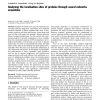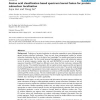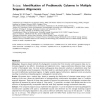157 search results - page 13 / 32 » Computational identification of ubiquitylation sites from pr... |
NCA
2006
IEEE
13 years 8 months ago
2006
IEEE
Scientists involved in the area of proteomics are currently seeking integrated, customised and validated research solutions to better expedite their work in proteomics analyses and...
NAR
2011
12 years 11 months ago
2011
The primary purpose of PHOSIDA (http://www .phosida.com) is to manage posttranslational modification sites of various species ranging from bacteria to human. Since its last report...
BMCBI
2010
13 years 9 months ago
2010
Background: Prediction of protein localization in subnuclear organelles is more challenging than general protein subcelluar localization. There are only three computational models...
BMCBI
2008
13 years 9 months ago
2008
Background: Residue depth allows determining how deeply a given residue is buried, in contrast to the solvent accessibility that differentiates between buried and solvent-exposed ...
ALMOB
2008
13 years 9 months ago
2008
Motivation: Sequence-based methods for phylogenetic reconstruction from (nucleic acid) sequence data are notoriously plagued by two effects: homoplasies and alignment errors. Larg...



